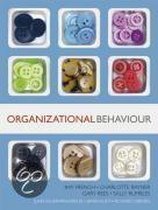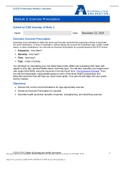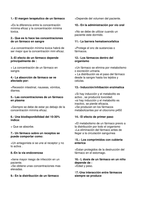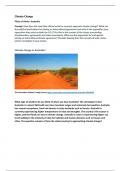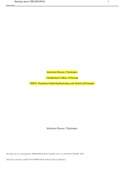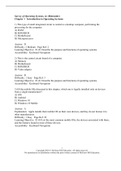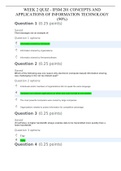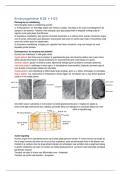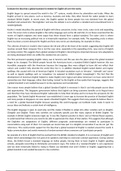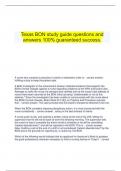Inhoud Organizational Behaviour
1. Course overview.......................................................................................................................................3
2. What is a good company to work for?..................................................................................................3
3. What makes a company successful?.....................................................................................................4
4. Defniton: Organizatonal Behaviour BOBO............................................................................................4
5. TOPICS..................................................................................................................................................4
Chapter 1: What is organizatonal behaviour?.............................................................................................5
1. Overview:.............................................................................................................................................5
1. Why a course in organizatonal behaviour? What is it about?..............................................................5
2. What are the challenges of today’s organizatons?..............................................................................7
3. Can OB inform us about the impact of culture and values on organizatons?....................................12
4. Research Artcle..................................................................................................................................13
Chapter 2: percepton value and personality diferences...........................................................................15
1. Overview.............................................................................................................................................15
1. Social Percepton................................................................................................................................16
2. Linking percepton to organizatonal behaviour.................................................................................21
3. Abilites, values, and personality 6.....................................................................................................21
4. Values - Stable preferences................................................................................................................24
5. Research paper...................................................................................................................................25
Chapter 3: Job design and fexible work arrangements..............................................................................25
1. Overview.............................................................................................................................................26
2. Motvaton..........................................................................................................................................26
2. Approaches.........................................................................................................................................27
3. JOB DESIGN PREFERENCE & GROWTH NEED STRENGTH....................................................................30
4. Presentaton.......................................................................................................................................34
Chapter 4: Groups and Teams....................................................................................................................34
1. Overview.............................................................................................................................................34
2. How does group structure infuence group performance?.................................................................36
3. How does “group dynamics” infuence performance?.......................................................................40
4. Why teams?........................................................................................................................................41
5. Paper..................................................................................................................................................44
Chapter 5: Motvaton................................................................................................................................44
1. Overview.............................................................................................................................................44
1
, 1. Empowerment and self-efcacy.........................................................................................................46
2. Motvaton theories B1O content, B2O process, B3O drives.....................................................................47
3. Extrinsic versus intrinsic motvaton...................................................................................................53
4. Research paper...................................................................................................................................55
Chapter 6: Leadership................................................................................................................................56
1. Leaderschip.........................................................................................................................................56
2. Traditonal approach to leadership.....................................................................................................58
3. New leadership perspectves..............................................................................................................61
4. Research paper...................................................................................................................................65
Chapter 7: Power........................................................................................................................................66
1. Outline................................................................................................................................................66
1. Power actvates and changes norms...................................................................................................66
2. Power in organizaton.........................................................................................................................67
3. Sources of power................................................................................................................................68
4. Paper..................................................................................................................................................71
Chapter 8: Communicaton and confict in organizatons...........................................................................71
1. Outline................................................................................................................................................71
2. How to implement efectve communicaton in organizatons?.........................................................71
3. How to deal with confict?..................................................................................................................75
4. Paper..................................................................................................................................................77
2
,Organizational behavior
EXAMEN
Half open vragen Bwoorden/zinnen invullen; GEEN essayvragenO joepie :D 10-20 open
Half meerkeuze Bgeen giscorrecte, maar 60% om te slagenO 30-40 vragen
Zie studiegids, als je deze vragen kan invullen, kan je ook het examen. Probeer in te beelden wat de prof
zou vragen.
1. Course overview
Part of Organizatonal Sciences curriculum
Builds on principles in psychology and sociology
Focus: how individuals behave in structured groups
Link with Human Resource Management
AIM:
B1O Theoretcal knowledge Bempirical researchO
B2O Applicatons for real-life problem solving
Be.g., guest lecture on mergers & acquisitonsO
2. What is a good company to work for?
Which companies do you know to have a good BbadO reputaton? Why BnotO?
Where would you like / not like to work?
A good company to work for ofers: Quality leadership / work/life balance
Team spirit
Fair and respectul treatment / Recogniton
Personal challenges / Opportunity for promoton
“are the best companies to work for the best companies?”
Companies are only as good as the people that work there!
Correlaton between satsfacton and org performance = 0.3 Bnot terribly strong; need to know
the contngency factors that boost correlatonO
Also need to know the directon of correlaton; fortunately for OB satsfacton causes good
performance; not the opposite.
3
, This queston is also the essence of OB and HRM. Both felds seek a balance between employee
well-being an org. performance. But HR asks “what can the company do to improve employee
well-being,” while OB asks, how does the individual help or hurt the company performance.
3. What makes a company successful?
If companies are only as good as the people that work there, we need to ask:
How do employees learn the tricks of the trade, and how do they plan their career in the
company?
How to motvate employees?
Does the organizatonal climate mater?
What type of leadership is needed?
Are there obstacles to cooperaton and communicaton within the organizaton?
4. Definition: Organizational Behaviour (OBa
Organizatonal behaviour = the study of all factors Bpersonal, contextual, and insttutonalO that
impact individual behaviour or group dynamics within an organizaton.
An additonal goal is to apply this knowledge to optmize an organizaton’s success.
Knowledge of OB benefts an organizaton’s employees, management, leaders, as well as anyone who is
in any way involved with organizatons.
About this course: I’s about understanding the link between empirical research, theory, and applicaton
How and why is the feld of Organizatonal Behaviour relevant?
What are the theoretcal predictons derived from research in the feld?
How does theory contribute to evidence-based management?
5. TOPICS
What’s the point of Organizatonal Behaviour?
Percepton-, culture-, value- and personality diferences
Motvaton
Job design and goal setng
Groups & Teams
Leadership
Power
Communicaton & confict
Evaluaton
4
,Chapter 1: What is organizational behaviour?
1. Overview:
2. Why a course in organizatonal behaviour BOBO, and what is it about?
3. What are the challenges that today’s organizatons have to meet?
4. Can OB inform us about the impact of culture and values on organizatons?
5. Paper: How to induce cooperaton between individuals with opposing social value orientatons.
1. Why a course in organizational behaviour? What is it about?
Organizatons are interestng.
All of us are in touch with organizatons, from birth to death.
Organizatons are important
Success today does not imply success tomorrow. We learn and structure our groups accordingly.
Organizatonal behaviour makes the diference
“Best companies to work for are best companies”
Def Organizatonal Behaviour = the study of all factors Bpersonal, contextual, and insttutonalO that
impact individual behaviour or group dynamics within an organizaton.
BUnderlying assumpton here is that individual and group behaviours impact organizaional performanceO
Performance equaton
Job performance = attributes work effort organisational support
Organisaton has to do something in return for work
If one of this factors is zero, you have NO job performance
Human resource performance = a social exchange Bsocial exchange implies a psychological
contractO
Contributions – What does the employee offer the organization? (or vice versa)
Inducements- What does the employee receive in return from the organization? (or vice
versa)
→ Need to find a balance
Social exchange implies a psychological contract….
Comprises the unspoken expectations that employees and organizations have of each
other.
The psychological contract relies on mutual trust.
What happens when the psychological contract is broken?
o Voice yourself / be quiet
o Neglect / destroy
o Quit
5
,Trust can be broken. So organisations also have formal contracts that specify sanctions when
agreements are violated.
Dependent variables in the performance equaton
“Job performance”
Productvity, ROI Breturn on investmentO, ROA Breturn on assetsO: BfnancialO
“Fortune 100” Blegitmacy of organizatonO
Absenteeism B= when people are absent, they don’t workO / Engagement BmotvatonO
Commitment BturnoverO
Satsfacton / job stress Bsuccess or failureO
Corporate Social Responsibility
Most challenging aspect of OB = measuring performance of an individual
Plus queston: does adding up all individual performances to organizatonal performance?
Independent variables
An independent variable has no or litle efect at itself
Ex. Leadership: what kind of leader you need depends on what kind of job, culture, 6 you have
<-> all together they have a lot of efect
Look for the interacton efects
Goal: to investgate the relaton between dependent and independent variables; obtain knowledge by
which to explain, predict, and direct human behaviour.
Problem: very few absolute “laws” in the social sciences; need for a contingency approach.
X leads to Y only when conditon Z is met.
BThis is an example of an interactve efect of X and Y on Z O
Problem with “common sense thinking” or stereotypical thinking. For example Theory X1 = people need
to be coerced to work because they are inherently lazy vs theory X2 = people need to be autonomous to
6
,provide the best work. Well, it depends on Z1 BpersonalityO, Z2 Btype of workO, Z3 Bmotvaton at that
tme, eg, sleepynessO66
Another caveat is ecological validity; you cannot infer what one individual will do based on your
statstcs of the group. If your strategy to ma e people wor s with e5 % conddenceg there are stll- on
averageg 5 % of people for whom it won’t wor . And your conddence level says nothing about the size
of your effect. One independent variable may have a small efect; but take many of them together, and
you have a larger predictve value of how people will behave.
2. What are the challenges of today’s organizations?
Why do they exist? Insttuton, cooperate and collaborate synergy B= together you work beter then
separatelyO => Need to frst understand why organizatons exist and what do they do
Why do organizatons exist?
An organizaton is:
An insttuton consistng of a coordinated group of people who cooperate together to achieve a
common goal
If the goal is to deliver a product or service, organizatons can engage in division of labor, and
provide synergy.
How does this work?
Common goal = economic growth
This is the old view of organizatons as open systems. Printed in your tekstbook untl the most
recent revision.
Not that there is anything wrong with it, but it is so simplifed. Human resources do not work
like machines. They have a mind of their own!
On top of it, maybe economic
growth is not as desirable
today as it was 100 years ago.
7
, 21st century Change the goal!
Organizatons should operate within
the doughnut
Donut: instead of growing , you should
realize how to operate without ruin the
earth and hurtng other people
Movies Kate Raworth: humans are
often not considered in economic
models Bwho are we?O
we need more than economic growth
sustainable growth, 6 Ba lot of terms
are being introduced, they point out
that we need something more than just
growthO
How do we do business in the dougnut and change the curve of economic growth?
1. Change the goal
Change the models, not only growth but also focus on people
2. See the big picture
instead of an contained model with compettve market, you need to look at an imbedded market ; look
outside the market
8
, 3. Nurture human nature
We are social creatures, not just ratonal. We need to nurture the social part Borg can do thisO
Typically, our economy revolves around corporatons that do business within a market, restricted by the
state. They do whatever is legal to grow. The typical goal therefore is to maximise profts untl
environmental taxes or quotas are introduced, putng a constraint on growth, and forcing a change of
incentves. But, once that hurdle is over with, its just growth like usual.
Times are changing fast – wine makers and silk weavers are realizing that their product supply change is
being changed by global warmingnand climate changes. They need to start thinking long term. While
some companies are evidently choosing to cheat Be.g. Volkswagen and the software that switched
engines into a low emission mode when testedO, other companies are truly going green or truly investng
in CSR Beg, having a net-zero impactO.
In additon to corporatons, other organizatons will gain in importance. Commons and household have
not been paid, yet they fulfll a huge role in the economy without being valued. Eg, Adam Smith’s
mother.
Why should creatng a logo be more important than raising children?
We can learn much from how commons are organized and managed, typically also without pay. Water
reserves and fshing grounds in small scale societes have been managed efectvely for many centuries
witout making profts. Through privatzaton Band eye on economic growthO many public lands have been
ruined.
Cooperate and coordinate, trust, be generous
4. Get savy with systems
9


